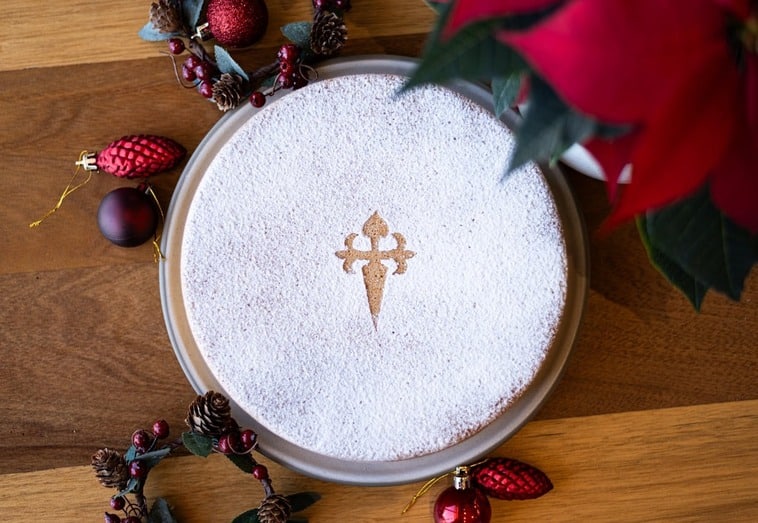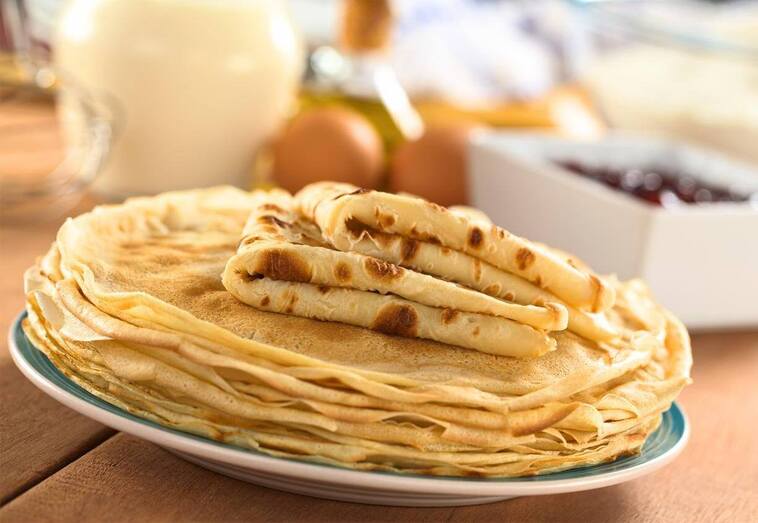The Best Desserts of Galicia

Table of Contents
Galicia and food
Galicia, as we know, is a land of very diverse and rich gastronomy, but for those with a sweet tooth, today we will talk about the best desserts of Galicia.
Tarta de Santiago: one of the best desserts of Galicia
Tarta de Santiago is one of the most iconic and best desserts of Galicia, especially known for its simplicity and delicious flavor. This cake has a strong connection with the region of Santiago de Compostela, both because of its name and its link to the tradition of the Camino de Santiago.
Tarta de Santiago has a historical origin that dates back to the Middle Ages. Although it is not possible to pinpoint exactly when it was first made, it is known that by the 16th century, it was already well known in the city of Santiago de Compostela. In its earliest versions, the cake was a humble dessert, consumed by pilgrims who arrived in the city to venerate the apostle Saint James. It is said that its recipe was inspired by the ingredients available in the region, such as almonds, which were cultivated locally.
The shape of the Santiago cross that decorates the cake is a direct reference to the famous cross of the pilgrims, a symbol of the Camino de Santiago, giving it a very strong cultural connection.
The original recipe for Tarta de Santiago is surprisingly simple, mainly based on local ingredients that are easy to find. The essential ingredients include:
- Almonds: They are the main ingredient, and the cake is known for its soft and moist texture thanks to them.
- Sugar: To sweeten the dough.
- Eggs: These help bind the ingredients together and give body to the cake.
- Lemon: The zest is usually used to give a fresh and aromatic touch.
- Flour: In the most traditional version, flour is used in smaller quantities, making it lighter.
- Cinnamon: Some versions include a touch of cinnamon, although this depends on the specific recipe.
The recipe doesn’t use large amounts of wheat flour, which gives it a denser and moister texture than a conventional cake.
In 2006, Tarta de Santiago received the Denomination of Origin as an official dessert of Galicia, which protects its recipe and ensures that only products made in the region under specific conditions can bear its name. Additionally, the cake is considered one of the most popular and widely exported desserts from the region
Galicia travel products
-

Rias Baixas Excursion
Rated 4.93 out of 530,00€ – 55,00€Price range: 30,00€ through 55,00€ Select date(s) This product has multiple variants. The options may be chosen on the product page -

French Way
360,00€ – 2.150,00€Price range: 360,00€ through 2.150,00€ Select options This product has multiple variants. The options may be chosen on the product page -
Sale!

Finisterre, Muxía, Costa da Morte
Rated 4.94 out of 520,00€ – 49,00€Price range: 20,00€ through 49,00€ Select date(s) This product has multiple variants. The options may be chosen on the product page -

English Way – Northern Way
370,00€ – 1.610,00€Price range: 370,00€ through 1.610,00€ Select options This product has multiple variants. The options may be chosen on the product page
Tarta de Mondoñedo
The Tarta de Mondoñedo is one of the most traditional and characteristic desserts of the province of Lugo, in Galicia. Originating from the town of Mondoñedo, this cake is famous for its unique flavor and for being a a key element of Galician pastry. Like other of Galicia’s best desserts, the cake has a history that intertwines with the culture and customs of the area.
The Tarta de Mondoñedo has a long tradition dating back to the 19th century. Its origin is said to be linked to an old bakery in the town, known as the Pastelería Casa de la Tarta de Mondoñedo, which began making this cake to satisfy local customers and pilgrims arriving in the city. The dessert became so popular that it quickly spread throughout Galicia and beyond, becoming a symbol of Mondoñedo’s gastronomy.
The recipe for Tarta de Mondoñedo varies slightly depending on the baker, but the basic ingredients are quite common. It is characterized by having a shortcrust pastry base and a creamy, smooth filling made of egg yolks, almonds, sugar, and typically a Galician liquor such as orujo.
- Shortcrust pastry: The base of the cake is a crunchy dough made with butter, flour, sugar, and water. It is similar to a classic pie crust but has a softer, more delicate touch.
- Egg yolk filling: The filling is creamy and has a smooth texture, thanks to the egg yolks, sugar, and, in some versions, ground almonds. This gives it a very distinctive, sweet, and delicate flavor.
- Galician liquor: In some versions, orujo liquor or the Galician herb liquor is added to the filling, giving it a distinctive flavor.
- Almond: Almond is a key ingredient in many Galician recipes, and in the Tarta de Mondoñedo, it is used both in the filling and as a decoration.
In Mondoñedo, the cake is much more than just a dessert; it is an emblem of the city. It is even said that the cake has a special connection to local history, as it was traditionally offered to visitors and travelers who arrived in the town. Today, the cake is an important symbol of Lugo’s pastry tradition and an excellent example of Galicia’s rich baking heritage.
Read also : THE STORY BEHIND SANTIAGO’S CAKE
Galician Filloas
Galician filloas are one of the most traditional, beloved and best desserts of Galicia, and can be considered a type of crepes or pancakes, but with distinctive characteristics that make them unique within the region’s gastronomy. This dessert is mainly associated with Carnival celebrations (known as “Entroido” in Galicia), Holy Week, and other important festivities. Although they are enjoyed throughout the year, it is during these times that they are made in larger quantities, making them the quintessential festive treat.
Filloas have an ancient origin, likely linked to Galicia’s agricultural and rural traditions. It is believed that the recipe dates back to medieval times, and like many other traditional dishes, it has been passed down from generation to generation, adapting over time.
The name “filloa” comes from the Latin “filia,” which means daughter, and refers to the idea that these thin layers of dough were “daughters” or “sisters” of French crepes, although they are prepared differently. Filloas are also part of a tradition of “feeding” people during festive times, especially within the framework of religious or popular celebrations.
Galician filloas have a simple yet delicious recipe. The basic ingredients are as follows:
- Flour: The base of the dough is flour, and traditionally, either wheat flour or corn flour is used, depending on the regional variation.
- Milk: In some recipes, only milk is used, while in others, water is also included. The milk helps to make the dough softer.
- Eggs: To give the dough structure and make it fluffier.
- Sugar: In some versions, a bit of sugar is added to the batter, while in others, the filloas are left unsweetened, depending on whether they will be filled or not.
- Salt: To balance the flavors.
- Liquor (optional): Some recipes include a splash of aguardiente, orujo, or herbal liquor, which gives it a distinctive flavor and a slight alcoholic kick.
- Oil or lard: To fry the filloas in the pan.

Varieties of Filloas
In Galicia, there are several ways to make filloas, and the differences mainly lying in the ingredients and preparation techniques:
- Sweet Filloas: In these, sugar is added to the dough and, sometimes, they are filled with jam, honey, or even pastry cream. These are especially popular during Carnival and Easter.
- Savory filloas: They are often filled with savory ingredients such as fried pork cracklings (pieces of fried pork meat), fried eggs, cheese, or cured meats, and are very common during winter or family celebrations.
- Blood filloas: These are a special variant of savory filloas, where pig’s blood is used in the batter, giving them a unique flavor. They are a gastronomic tradition in several rural areas of Galicia, such as Ribeira Sacra.
- Stuffed filloas: These can be filled with cream, whipped cream, jams, or even chocolate, and then folded or rolled, transforming them into a much more substantial dessert.
Read also : 9 TYPICAL GALICIAN DESSERTS
Filloas: Tradition, Festivities and Modernity
Filloas play an important role in various celebrations in Galicia. During Carnival (or “Entroido”), they are a key sweet in the festivities and undoubtedly one of the best desserts of Galicia. In many Galician homes, large quantities of filloas are prepared to share with family and friends, and they are seen as a way to welcome the end of winter.
During Holy Week, many filloas are also prepared, especially in rural areas, where both sweet and savory versions are made as part of the traditional food for these dates. They are perfect to accompany dishes like cod or the typical stews of Lent.
Today, filloas remain a very beloved dessert in the Region of Galicia, and it is common to find both traditional and innovative versions in Galician restaurants and homes. Although some recipes have evolved to adapt to modern tastes, the essence of the dish remains the same: a simple, versatile, and delicious treat that can be enjoyed in multiple ways
Discover Galicia with Us
“As you can see, Galicia is a region that invites all kinds of experiences. Galicia is a completely versatile and beautiful region that deserves to be explored down to the last inch, no matter the time of year. It has much to offer for all tastes. At Galicia Travels, we provide the best experiences to discover the magic of the northwest of Spain.”
